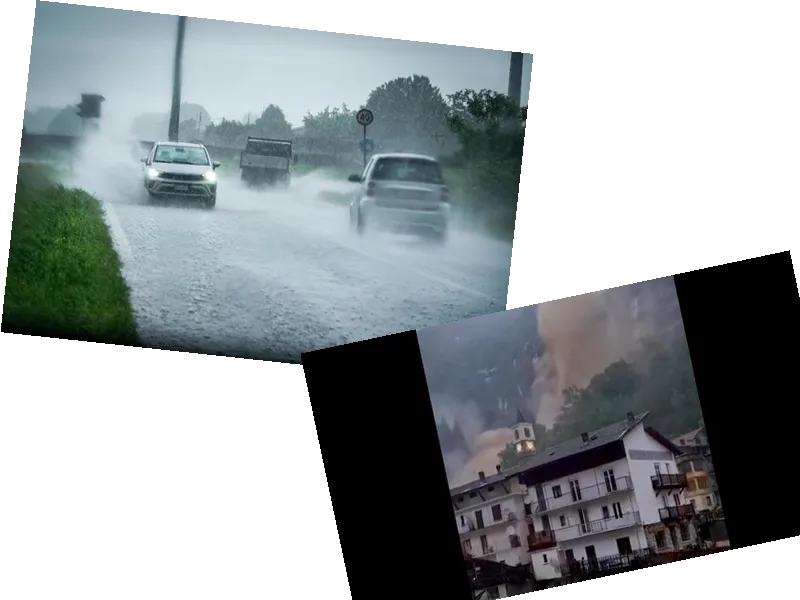The new week will still be marked by strong weather instability with several thunderstorms, showers and local hailstorms especially in the northern regions. However, the meteorological picture is destined to undergo a new and decisive change. It is the weather forecast of the website www.iLMeteo.it. The announced phase of strong atmospheric instability, meteorologists explain to ANSA, 'will find its origins in a vast low pressure system, centered between the British Isles and Scandinavia, which will send 2 disturbed impulses towards the Mediterranean, first influencing Northern Italy and subsequently also the rest of the Peninsula.'
Monday 1 July will see the arrival of the first unstable front ready to cause showers and thunderstorms, especially in the northern regions. Lombardy, Veneto, Friuli Venezia Giulia and towards the evening also Emilia will be particularly at risk of intense phenomena. The high concentration of heat and humidity accumulated in the lower layers of the atmosphere, combined with the strong contrasts between different air masses, will create the ideal conditions for the development of impressive storm cells. These systems, the experts point out, 'could trigger heavy showers, sudden gusts of wind and local hailstorms.'
The bad weather may still affect Piedmont and Val d'Aosta, but to a lesser extent than what happened between Saturday 29th and Sunday 30th June when mudslides and flash floods affected the center of Cervinia and the Cogne Valley. This instability will then continue between the evening of Tuesday 2nd and Wednesday 3rd July, with a second impulse which will bring the risk of strong thunderstorms immediately to the North-West and then heading, by Wednesday, to a good part of the Centre-South. This front will be accompanied by cooler air coming from northern Europe, resulting in a drop in temperatures which could even drop below seasonal averages.
For a definitive improvement, the meteorologists conclude, 'we will have to wait until Thursday 4 July.' The images are impressive. Northern Italy, like much of the eastern half of France, was plagued by violent bad weather this Saturday. The Italian regions of Piedmont and the Aosta Valley were particularly affected at the end of the day, and several municipalities found themselves trapped by rising waters.
In Noasca, a village of less than 200 inhabitants located around twenty kilometers from the French border, the images posted on social networks demonstrate the seriousness of the situation. More than 100 mm of rain fell there during the day, according to the local press. Located below a valley at an altitude of 1,000 m, the town suffered heavy flooding after waterfalls, leading to a landslide which swept away everything in its path. Further up, in the Aosta Valley, the town of Cogne found itself isolated because of these storms. Videos of vehicles being swept away at high speed by the floods were filmed and broadcast by residents of the region. According to Corriere della Sera, other towns in the region, some full of tourists, are affected by bad weather and have been forced to ban traffic.
Severe hailstorms were also observed in the region. For the moment, no reports of injuries or victims have been communicated by the Italian authorities and the local press.
- The weather forecast highlights the significant impact of a low pressure system from the British Isles and Scandinavia, which is expected to bring two disturbed impulses towards the Mediterranean. This will first affect Northern Italy and then extend to the rest of the Peninsula.
- The first unstable front is set to arrive on Monday, July 1st, bringing showers and thunderstorms, particularly to Lombardy, Veneto, Friuli Venezia Giulia, and Emilia. The combination of heat, humidity, and contrasting air masses will create conditions conducive to the development of intense storm cells.
- The instability will persist between Tuesday evening and Wednesday, with a second impulse bringing strong thunderstorms to the North-West and subsequently to the Centre-South. Cooler air from northern Europe will accompany this front, leading to a drop in temperatures below seasonal averages.
- The regions of Piedmont and Aosta Valley were particularly affected by severe weather over the weekend, with heavy rainfall causing mudslides and flash floods. Noasca experienced significant flooding due to a landslide, and Cogne was isolated by the storms.






